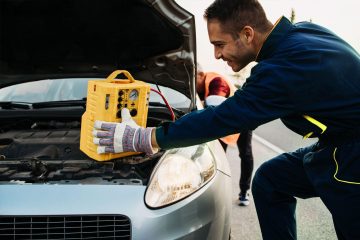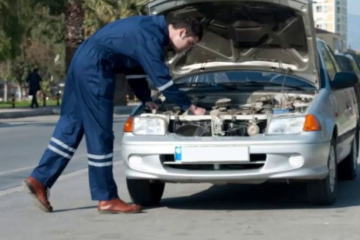Ever been stranded on the side of the road, frantically googling “mobile mechanic near me” only to find zilch? Yeah, it’s not fun. But don’t sweat it – I’ve got your back with this ultimate guide to handling car breakdowns when a mobile mechanic is MIA.
Let’s face it, car troubles always seem to pop up at the worst times. Maybe you’re on a road trip, miles from the nearest town, or stuck in rush hour traffic. Whatever the scenario, knowing how to handle a breakdown can save you tons of stress (and cash).
I remember the time my trusty old Chevy decided to give up the ghost on a lonely stretch of highway in Arizona. No cell service, no nearby towns, and definitely no mobile mechanics. Talk about a wake-up call! That experience taught me the importance of being prepared for anything on the road.
So, buckle up as we dive into everything you need to know about tackling car breakdowns like a pro, even when professional help isn’t an option.
Safety First: Your Top Priority
Before we get into the nitty-gritty of car repairs, let’s talk safety. When your car conks out, your first move should always be getting to a safe spot.
If you’re on the highway, try to coast to the shoulder. Turn on your hazard lights ASAP – this is crucial for alerting other drivers. If you’ve got a reflective triangle or flares in your emergency kit (more on that later), set those up behind your car.
Once you’re safely off the road, stay in your car if possible. It’s way safer than standing on the shoulder, especially if visibility is low or traffic is heavy.
Assess the Situation: What’s Really Wrong?
Okay, you’re safe. Now what? Time to play detective and figure out what’s going on with your ride.
Is the engine making weird noises? Did it just suddenly die? Are you out of gas? (Hey, it happens to the best of us!)
Take a deep breath and try to recall any warning signs you might have noticed before the breakdown. Was the check engine light on? Did you hear any strange sounds?
This info will be super helpful when you eventually talk to a mechanic or tow truck driver.
The DIY Approach: Basic Troubleshooting
Now, I’m not saying you need to become a master mechanic overnight. But knowing a few basic troubleshooting steps can be a real lifesaver.
Here are some common issues and quick fixes:
- Dead battery: Got jumper cables? If another driver stops to help, you might be able to jump-start your car.
- Overheating: If your temperature gauge is through the roof, turn off the AC and crank the heater (I know, it sounds crazy). This can help draw heat away from the engine. Pull over, pop the hood, and let things cool down for at least 15 minutes before checking the coolant level.
- Flat tire: Time to put that spare to use! Just make sure you’re in a safe spot before attempting a tire change.
- Out of gas: If you’ve got a gas can in your emergency kit, you might be able to hoof it to the nearest station. Otherwise, it’s time to call for help.
Remember, if you’re not 100% sure what you’re doing, it’s better to wait for professional help. The last thing you want is to make the problem worse!
Phone a Friend: Your Personal Rescue Squad
When you’re stuck on the side of the road, a familiar voice can be a real comfort. Give a trusted friend or family member a call. They might be able to:
- Help you brainstorm solutions
- Look up local mechanics or tow services for you
- Come pick you up if you’re nearby
- Bring you gas or other supplies if needed
Plus, it’s always good for someone to know where you are in case of an emergency.
Roadside Assistance: Your Secret Weapon
If you’ve got roadside assistance through your insurance, a credit card perk, or a service like AAA, now’s the time to use it!
These services can typically help with:
- Towing
- Jump starts
- Tire changes
- Fuel delivery
- Lockout services
Even if you don’t have a dedicated roadside assistance plan, many insurance companies offer basic roadside help. It’s worth giving them a call to see what they can do for you.
Local Mechanics: Finding Help in a Pinch
No mobile mechanic available? Time to get creative. Here are some ways to find local help:
- Google is your friend: Search for “mechanics near me” or “auto repair shops near me”.
- Ask Siri or Google Assistant: These virtual helpers can often find nearby services quickly.
- Check review sites: Yelp, Google Reviews, and Facebook can give you an idea of which local shops are trustworthy.
- Ask locals: If you’re near a gas station or convenience store, the staff might be able to recommend a reliable mechanic.
- Social media: Post on local Facebook groups or NextDoor. Sometimes, a neighbor or community member might be able to help out.
Remember to always prioritize your safety. If a situation feels sketchy, trust your gut and wait for official help.
Tow Truck Time: When All Else Fails
Sometimes, despite your best efforts, you just can’t get your car moving again. That’s when it’s time to call in the big guns – a tow truck.
When calling for a tow, be sure to:
- Get an estimate upfront
- Confirm they can take you to your preferred repair shop
- Ask about payment methods (cash, credit card, etc.)
- Get an ETA and the driver’s name
While waiting for the tow truck, stay with your vehicle if it’s safe to do so. If you need to leave, leave a note on the dashboard with your contact info and where you’ve gone.
The Ultimate Emergency Kit: Be Prepared for Anything
Remember my Arizona breakdown story? That taught me the importance of a good emergency kit. Here’s what I always keep in my trunk now:
- Jumper cables
- Flashlight (with extra batteries)
- Basic tool kit
- Duct tape (seriously, it can fix almost anything temporarily)
- Spare tire (make sure it’s properly inflated!)
- Jack and lug wrench
- Reflective triangles or flares
- First aid kit
- Blanket
- Non-perishable snacks and water
- Phone charger
- Small fire extinguisher
- Work gloves
- Rain poncho
It might seem like overkill, but trust me, you’ll be glad to have these items if you ever need them!
Preventive Maintenance: The Best Defense
Look, I get it. Car maintenance isn’t exactly thrilling. But taking care of your ride can save you from a world of hurt down the road.
Here are some basic maintenance tasks to keep on top of:
- Regular oil changes
- Tire rotations and pressure checks
- Battery checks
- Brake inspections
- Fluid level checks (coolant, brake fluid, power steering fluid, etc.)
Set reminders on your phone or mark your calendar. Your future self will thank you!
Tech to the Rescue: Apps for Car Emergencies
We live in a digital age, so why not use tech to your advantage? Here are some handy apps to have on your phone:
- Waze: Great for real-time traffic updates and finding nearby gas stations.
- GasBuddy: Helps you find the cheapest gas prices near you.
- RepairPal: Estimates repair costs and helps you find certified mechanics.
- FIXD: Connects to your car’s computer to diagnose issues (requires a separate sensor).
- Roadside America: Perfect for long road trips, it helps you find quirky attractions and rest stops along your route.
When All Else Fails: The Waiting Game
Sometimes, despite your best efforts, you might find yourself stuck for a while. Here’s how to make the best of it:
- Stay comfortable: Use your emergency blanket if it’s cold, or find shade if it’s hot.
- Stay hydrated: Sip on water from your emergency kit.
- Stay entertained: Books, podcasts, or downloaded movies can help pass the time.
- Stay informed: Keep friends or family updated on your situation.
- Stay visible: Keep your hazard lights on and stay with your vehicle if it’s safe to do so.
Learning from the Experience: Post-Breakdown Reflection
Once you’re back on the road, take some time to reflect on the experience. What went well? What could have gone better? Use this as a learning opportunity to be even more prepared next time.
Consider taking a basic car maintenance class or watching some YouTube tutorials. The more you know about your car, the better equipped you’ll be to handle future issues.
Case Study: Sarah’s Roadside Triumph
Sarah, a graphic designer from Denver, Colorado, found herself in a sticky situation when her car broke down on a mountain road during a camping trip.
“I was terrified,” Sarah recalls. “No cell service, no other cars in sight. But then I remembered the emergency kit my dad insisted I keep in the trunk.”
Using her flashlight and basic tool kit, Sarah was able to identify a loose battery connection. With a little tightening, she got her car started and made it safely to the nearest town.
“That experience taught me the value of being prepared,” Sarah says. “Now I make sure all my friends have emergency kits too!”
FAQs: Your Burning Car Breakdown Questions Answered
Q: What should I do if my car breaks down in a tunnel or on a bridge?
A: Safety is key here. Turn on your hazard lights immediately. If possible, try to coast to an emergency pull-off area. If not, stay in your car with your seatbelt on and call for emergency assistance.
Q: Is it safe to accept help from strangers during a breakdown?
A: While many people have good intentions, it’s best to err on the side of caution. If someone stops to help, thank them but explain that you’ve already called for assistance. If you feel unsafe, lock your doors and call 911.
Q: How can I prevent my car from breaking down?
A: Regular maintenance is key. Follow your car’s recommended service schedule, keep an eye on fluid levels, and address any unusual noises or performance issues promptly.
Q: What if I can’t afford a tow truck or repairs?
A: Look into local community assistance programs or churches that might offer help. Some auto parts stores also offer free diagnostic services that can help you understand the problem.
Q: Should I stay with my car or try to walk for help?
A: In most cases, it’s safest to stay with your vehicle. It provides shelter and makes it easier for help to find you. Only leave if you’re absolutely certain of the direction and distance to help.
Q: How can I make my car more visible during a breakdown?
A: Turn on your hazard lights, raise your hood, and tie a white cloth to your antenna or door handle. If you have them, set up reflective triangles or flares behind your vehicle.
The road can be unpredictable, but with these tips in your back pocket, you’ll be ready to handle whatever comes your way. Remember, staying calm and prioritizing safety are always the most important things.
So the next time your car decides to throw a tantrum, take a deep breath and remember – you’ve got this! And hey, maybe you’ll even have a great story to tell at your next dinner party. After all, the best adventures often start with a little unexpected detour.
Stay safe out there, road warriors!




